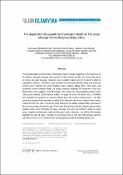Options
The Application of Laswell Communication Model on The Good Message Within Religious Malay Films
Journal
Ulum Islamiyyah: Malaysian Journal of Islamic Sciences
Date Issued
2021-04
Author(s)
Rosmawati Mohamad Rasit,
Muhamad Faisal Ashaari,
Salasiah Hanin Hamjah
DOI
10.33102/uij.vol33no1.273
Abstract
The general public perceives film as the factor that encourages negativity in the behaviour of its audience. However, through the perspective of film studies, the film can serve as the means to convey a good message. However, more in-depth reviews need to be done to attest to its capability in doing so. Therefore, using Laswell Communication Model (1948), this study was carried out to examine the good messages from religious Malay films. This study used qualitative content analysis design. by using purposive sampling, the researcher chose four Malay films as the subjects in this film study. The movies were Maut (Death) (2009), Syurga Cinta (Love Heaven) (2009) and Nur Kasih (The Light of Love) The Movie (2011). The films were watched and analysed by inserting all the facts into content analysis forms - the film meaning evaluation form and theme coding form. Narrative and theme analysis were used to analyse the film text data. Overall, the study found that the Malay religious films examined to discuss the concept of good message. There were four themes from the religious Malays films analysis which were promoting the good messages; the plays of emotions, based on the target group, negative reinforcement style and the good advice. However, not all the film samples highlight the idea of good messages in their purest sense as they are inharmonious with the principle of Amar Ma’ruf Nahi Munkar (encouraging good deeds, forbidding bad acts).
Subjects
File(s)
Loading...
Name
The Application of Laswell Communication Model on The Good Message Within Religious Malay Films.pdf
Size
374.03 KB
Format
Adobe PDF
Checksum
(MD5):265638817d199f717793b46ea6e78d00